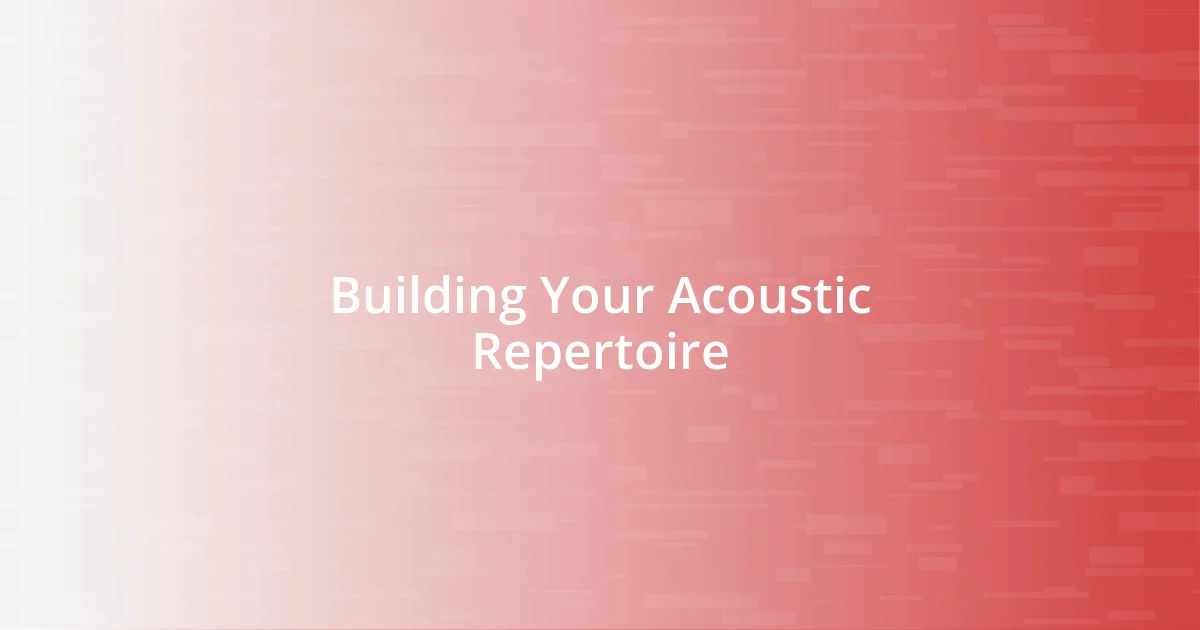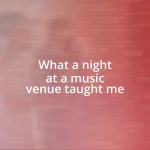Key takeaways:
- Acoustic sessions create an intimate atmosphere that fosters genuine emotional connections between performers and the audience.
- Choosing the right acoustic instrument and setting the environment are crucial for enhancing the overall experience and mood of performances.
- Evaluating performance through feedback and self-reflection helps in tracking progress and celebrating small victories, which fuels growth as a performer.

Understanding Acoustic Sessions Importance
Acoustic sessions hold a special place in my heart and are vital for creating an intimate atmosphere. I remember attending a small café performance where the artist’s raw vocals resonated with the audience, creating a shared experience that felt almost sacred. Have you ever felt the power of music strip away the distractions of life, leaving just the melody and emotion? That’s the beauty of acoustic sessions; they give us a chance to connect on a deeper level.
The simplicity of acoustic performances allows for genuine expression, making each note and lyric more impactful. I often find that in these settings, the connection between the performer and the audience is almost palpable. Isn’t it fascinating how a single guitar strum can evoke a flood of memories or emotions? It’s this immediate accessibility to raw talent that truly underlines the importance of acoustic music.
These sessions also foster collaboration and experimentation, providing artists with the freedom to explore their creativity. I recall a time when a small group of musicians started jamming together at an open mic night; they each brought unique styles and influences that culminated in something extraordinary. Doesn’t that remind you of how powerful and inspiring it is to witness artistry flourish in a supportive environment? In my experience, that’s where some of the most authentic musical moments occur.

Choosing the Right Acoustic Instrument
Choosing the right acoustic instrument is crucial for setting the mood and achieving the sound you desire in your sessions. For me, the warmth of a classical guitar’s nylon strings has a unique way of enveloping the listener, creating a soft, inviting atmosphere. It’s like wrapping your audience in a cozy blanket of sound, making every note feel more intimate. Have you ever strummed a guitar and noticed how the tone can change the feeling of a room instantly?
When comparing instruments, consider what resonates with your personal style. I’ve often found joy in the melodious nature of the ukulele, its lightness adding a playfulness to performances that leave people smiling. There’s something magical about how just a few chords can uplift spirits, which is why I often choose it for casual gatherings. It’s amazing how something so simple can create such a joyful energy, don’t you think?
In my experience, it’s essential to keep in mind your audience and the kind of atmosphere you want to create. I once attended a small outdoor concert featuring a stunning wooden cello, and the resonant, rich tones filled the air beautifully. The range of emotions it evoked was profound, demonstrating how the right instrument can enhance the overall experience. What would you choose, and how do you want your audience to feel during your acoustic session?
| Instrument | Sound Quality |
|---|---|
| Classical Guitar | Warm, Intimate |
| Ukulele | Bright, Playful |
| Cello | Rich, Resonant |

Setting Up Your Acoustic Environment
Creating the perfect acoustic environment is essential for delivering a memorable experience. I remember once setting up for an outdoor session in my backyard, taking the time to arrange the seating and lighting thoughtfully. It transformed the whole atmosphere into something magical, like a scene from a movie where everything just clicks. I learned that even the placement of chairs can influence how people connect with the music and each other, enhancing the overall vibe.
Here are some tips based on my experience to set the stage for a great acoustic session:
- Choose the Right Location: Look for spaces that enhance sound, like rooms with carpets or curtains that help absorb echoes.
- Consider Lighting: Soft, warm lighting creates a cozy vibe, drawing the audience’s attention to the performance without overwhelming them.
- Arrange Seating Thoughtfully: A semi-circle can foster connection between performers and the audience, making everyone feel included.
- Minimize Background Noise: If possible, avoid areas with heavy foot traffic or disruptive sounds that can take away from the music.
Each detail plays a significant role in crafting that intimate atmosphere that makes acoustic sessions so special. I can’t help but feel that when you get the environment right, it invites everyone to let their guard down, encouraging more authentic interactions.

Essential Techniques for Acoustic Performance
Focusing on the nuances of acoustic performance can dramatically enhance your delivery. One technique I’ve found incredibly effective is playing with dynamics. For example, during a quiet moment in a song, I’ve noticed how drawing the audience in with softer vocals can create an emotional weight that resonates deeply. It’s like a subtle dance with the energy in the room. Have you ever experienced that palpable silence when everyone leans in, waiting for the next note? That’s the magic I strive for.
Another essential technique is to incorporate breathing and pausing strategically. I remember a time when I was performing a heartfelt ballad; I paused briefly between verses. The silence felt almost electric, allowing the emotions to linger in the air. This technique not only heightens the impact of your lyrics but also gives the audience a moment to reflect on what they’ve just heard. It’s fascinating how a mere split second of stillness can transform a performance.
Don’t forget the power of storytelling during your acoustic sets. I often share a personal anecdote or the backstory of a song, drawing the audience into my world. There was a particular night when I explained the inspiration behind one of my songs; by the end, I could see connections forming among the listeners as they shared similar experiences. Isn’t it incredible how music, paired with a genuine narrative, can forge connections in such a profound way?

Building Your Acoustic Repertoire
Building your acoustic repertoire is really about curating a selection of songs that not only resonate with you but also connect with your audience. I’ve learned that having a diverse mix can keep things fresh and engaging. For instance, I always include a blend of well-known covers and original pieces; there’s nothing quite like seeing the crowd light up when they recognize a familiar tune. Have you ever noticed how a classic song can instantly lift the mood? It’s those shared moments that make performances unforgettable.
It’s also crucial to consider the emotional journey you want to take your listeners on. I remember one session where I prepared a setlist intentionally designed to ebb and flow, from uplifting tracks to deeply reflective ballads. This dynamic range kept the audience engaged and created a memorable emotional arc throughout the performance. Think about this: how do you want your audience to feel at the end of your set? Crafting a narrative arc in your playlist can bridge those connections, making each performance feel intentional.
Don’t shy away from experimenting either. I often tweak songs based on the vibe of the audience. One night, inspired by the energy in the room, I strayed from my usual list and played a spontaneous medley of favorite riffs. The surprise brought spontaneous applause and laughter, making that evening one of the most memorable for everyone involved. It’s those moments of spontaneity that can truly elevate an acoustic session, right? Embrace the evolution of your acoustic repertoire as it reflects your growth as a performer and storyteller.

Evaluating Performance and Progress
Evaluating performance and progress goes beyond just listening to a recording of your acoustic session. I often find it helpful to bring in feedback from a trusted friend or fellow musician. After a show, I might ask them what moments resonated with them or if they felt any songs fell flat. Their insights can provide a different perspective that I may have missed while lost in the moment. Have you ever thought about how an outside viewpoint can illuminate your strengths and the areas where growth is possible?
When I evaluate my progress over time, I like to document my performances. After each session, I jot down what worked well and what didn’t. I remember a time when I noticed a consistent struggle with a particular song’s pacing. By revisiting my notes, I could track improvements and identify patterns. It’s like building a personal map of my journey; seeing how far I’ve come motivates me to keep pushing my boundaries. Don’t you think having a record of your evolution can be incredibly empowering?
Lastly, I remind myself to celebrate small victories. Whether it’s mastering a challenging chord or feeling a genuine connection with the audience, each accomplishment adds to my growth as a performer. I distinctly recall a night where I nailed a tricky vocal run, and the rush of excitement afterward felt like a personal triumph. Have you celebrated your own milestones lately? Recognizing and appreciating these moments can fuel your passion and drive for acoustic sessions even further.















